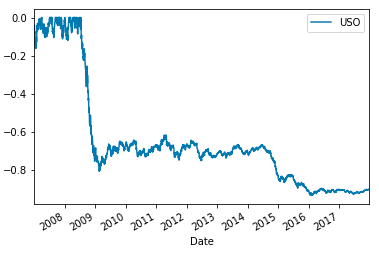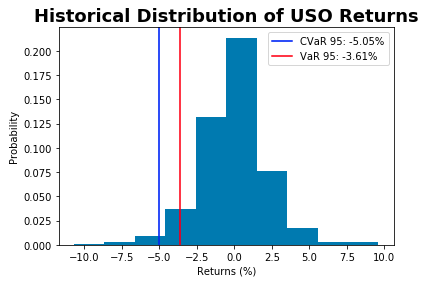Estimating tail risk
Introduction to Portfolio Risk Management in Python

Dakota Wixom
Quantitative Analyst | QuantCourse.com
Estimating tail risk
Tail risk is the risk of extreme investment outcomes, most notably on the negative side of a distribution.
- Historical Drawdown
- Value at Risk
- Conditional Value at Risk
- Monte-Carlo Simulation
Historical drawdown
Drawdown is the percentage loss from the highest cumulative historical point.
$$ \text{Drawdown} = \frac{r_t}{RM} - 1$$
- $r_t$: Cumulative return at time t
- $RM$: Running maximum
Historical Drawdown of the USO Oil ETF

Historical drawdown in Python
Assuming cum_rets is an np.array of cumulative returns over time
running_max = np.maximum.accumulate(cum_rets)
running_max[running_max < 1] = 1
drawdown = (cum_rets) / running_max - 1
drawdown
Date Return
2007-01-03 -0.042636
2007-01-04 -0.081589
2007-01-05 -0.073062
Historical Value at Risk
Value at Risk, or VaR, is a threshold with a given confidence level that losses will not (or more accurately, will not historically) exceed a certain level.
VaR is commonly quoted with quantiles such as 95, 99, and 99.9.
Example: VaR(95) = -2.3%

95% certain that losses will not exceed -2.3% in a given day based on historical values.
Historical Value at Risk in Python
var_level = 95
var_95 = np.percentile(StockReturns, 100 - var_level)
var_95
-0.023
Historical expected shortfall
Conditional Value at Risk, or CVaR, is an estimate of expected losses sustained in the worst 1 - x% of scenarios.
CVaR is commonly quoted with quantiles such as 95, 99, and 99.9.
Example: CVaR(95) = -2.5%

In the worst 5% of cases, losses were on average exceed -2.5% historically.
Historical expected shortfall in Python
Assuming you have an object StockReturns which is a time series of stock returns.
To calculate historical CVaR(95):
var_level = 95
var_95 = np.percentile(StockReturns, 100 - var_level)
cvar_95 = StockReturns[StockReturns <= var_95].mean()
cvar_95
-0.025
Let's practice!
Introduction to Portfolio Risk Management in Python

